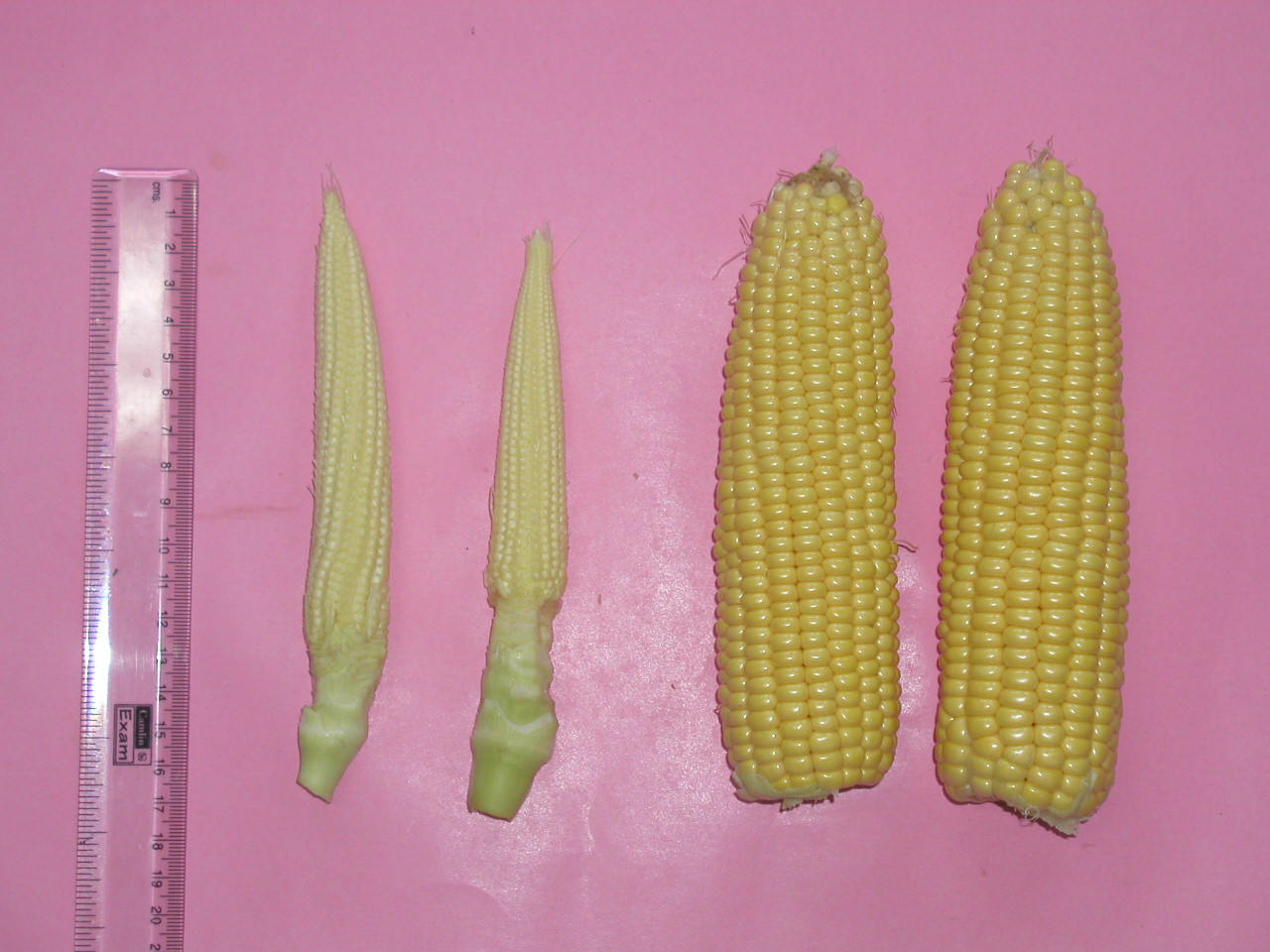
Crop: Baby Corn
Scientific name : Zea mays
Common / Local Name :
Baby corn is the ear of maize (Zea mays L.) plant harvested young, especially when the silks have either not emerged or just emerged, and no fertilization has taken place, depending on the cultivar grown. The dehusked young ears of baby corn can be eaten as a vegetable, whose delicate sweet flavour and crispiness are much in demand. Importantly, baby corn is free from pesticides and its nutritional value is comparable to popular vegetables like cauliflower, cabbage, tomato, eggplant and cucumber. Its by-products such as tassel, young husk, silk and green stalks provide good cattle feed.


The soil requirement, and preparation and crop management practices for baby corn are the same as that for sweet corn and popcorn. For baby corn two systems are used. One system uses standard populations of about 58000 plants per ha, where the top ear is left on the plant for grain corn or sweet corn, and subsequent ears harvested for baby corn. The second system uses high plant populations at a spacing of 45 cm x 20 cm with 2 plants per hill, having a population density of 175000 plants/ha, where all ears are harvested for baby corn. The standard plant populations produce yields of about 46.5 un husked ears (4.65 q husked ears) per ha, while the high populations produce yields of about 93-10.6 0 q un husked ears (9.3-10.60 q of husked ears) per ha.
A seed rate of 20-25 kg/ha is recommended. This would thereby realize more number of cobs and consequently more returns to the farmers. No variety has been exclusively bred for baby corn purpose in India. No variety has been exclusively bred for baby corn purpose in India. However, early and prolific varieties like HIM 123, VL-42, Him 129. Early composite and hybrid variety Prakash, PEHM 1 & 2 can successfully be cultivated as baby corn (Table 2). At the time of selection of cultivar preference is to be given for short stature and prolific cultivars. Hybrids are preferred over open pollinated varieties because hybrids are more uniform in flowering. Thus they may require only 4-5 time plucking. Contrary to this non uniform flowering of varieties leads to prolonged harvesting. Short stature materials can be well accommodated in higher plants densities.
List of cultivars recommended for cultivation for baby corn purpose and their growing season
Variety |
Hybrid |
Recom- |
Recom- |
Time to |
Yield |
Him 123, VL 42, Him 129,VL |
Ganga |
Kharif & |
Across |
45-50 |
1,50,000 |
Planting time is round the year in peninsular India and February to September/October in North India. Nitrogen is applied @ 150-200 kg/ha is three equal splits as basal dose at the time of sowing, at knee high stage (20-25 DAS) and at pre-tasseling stage (40-45 DAS). On the other hand, phosphorus and potassium are applied as basal dose at the usual rate of 60 kg/ha and 40 kg/ha, respectively.
For control of stalk borers Endosulfan 35 EC @ 2 ml/l is ksprayed on 10-14 days old plants.
The ears are harvested (45-50 days after emergence) when the silks are 1-2 cm long, i.e. within 1-2 days after silk emergence. Feed corn varieties are harvested at silking, while supers weet varieties may be harvested up to the time silks are about 5 cm long but still fresh. Ears quickly become too long and tough. Suitable time for harvesting of ears may be determined by sampling for size. Harvesting is usually done in the morning when the moisture is high and the temperatures are low. The picking of baby corn is to be done once in three days and generally 7-8 pickings are required depending on genotypes used. In a good crop, on an average 15-19 q/ha baby corn can be harvested. Additional income may also be obtained through sale of green fodder, which may yield up to 250-400 q/ha. The husk is to be carefully removed so as not to break or damage the ear. Ears intended for processing must be carefully hand husked and de-skilled. Subsequent to the removal of the ear husks, the shanks are cleared of the silks. Then the shanks are graded based on their size and colour and packed in polythene sheets before marketing. In many cases baby corn for vegetable use is marketed without dehusking of the cobs. This reduces labour involved in processing but fetches less market price. Optimum size for market and cannery industries are 4.5-10 cm long and 7-17 mm diameter of dehusked cobs. Yellow coloured cobs with regular row arrangement fetch better market rice. Harvested baby corn may be stored for 3-4 days at 10oC without much effect on its quality. For long term storage and distant transport, baby corn is canned in brine solution (3 %), sugar (2 %) and citric acid (0.3%) solution and stored under refrigerated conditions. Baby corn may also be stored in vinegar. Baby corn is also gaining popularity in Indian market and it already has an established international market, particularly in Europe.

Input availability |
Address/Contact details |
| Seeds |
|
Fertilizers |
|
Pesticides |
|
| Machineries |
|
|